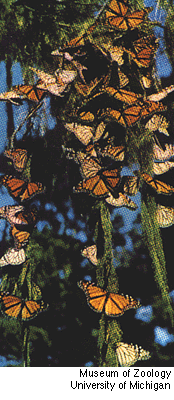| |
The number of monarchs that have migrated to the coast this year is not as impressive as last year, officials say, but is still considered a good showing. About 60,000 monarchs are clustered on eucalyptus trees in the Santa Cruz grove this year, compared to last year's peak of 150,000.
| |
"The monarchs are a symbol of hope and renewal and rebirth," she said.
"We're happy to host them."

But this year's turn out in Pacific Grove is about only half of what it was last year.
"We don't know why there are fewer this year," Vaccaro said. "It could be a combination of a whole bunch of things. Some entomologists say its cyclical." Forests fires, chemical spraying to kill med flies, parasites, storms and other natural and human activities are all possible contributing factors.
Vaccaro said one of the best times to visit the monarchs is during the week of Valentine's Day when they are usually mating. The monarchs arrive in late October, peak during December and January and begin to leave around the middle to the end of February and early March.
The sanctuary was established in 1990 by the voters of Pacific Grove. After the owner of the property sought permits to begin construction of housing units, local residents held a successful petition drive. The measure, which provided funds to buy the property and create a permanent safe haven for the monarchs, was approved by 69 percent of the voters, Vaccaro said.
Pacific Grove, dubbed "Butterfly Town USA," not only welcomes the monarchs back each year, it has staked a claim on their continued return for years to come. Throughout the small community on the Monterey Bay, there are shops, restaurants and places to stay which use the monarch butterfly in one form or another to promote their business.
"Almost everything we do has a butterfly on it," Moe Amarr of the Pacific Chamber of Commerce said. He estimates that tourism generated by the monarchs brings between $750,000 to $1 million in revenues for the town during the butterfly's stay. The town even hosts an annual Monarch Parade.
Amarr urges visitors to stop by the Museum of Natural History before going on to view the butterflies. He said visitors need to "learn the etiquettes of seeing the butterflies." And to demonstrate how serious towns folk are about protecting the monarchs, a law was passed two years ago that makes it illegal to harass the butterfly. Violators can receive fines as much as $500 for chasing or capturing a monarch, Amarr said.
"I ride my motorcycle through the 'butterfly zone' [in Pacific Grove] and it is so strange" said Christopher DiCicco, an Army captain studying at Monterey's Language Defense Institute. "What happens if I accidentally run over one of them?"
Founded in 1987, Friends of the Monarch's goal is education and conservation, Vaccaro said. "We have training films and hold lectures in schools; we've planted eucalyptus and Monterey pine trees," she said.
Each fall the monarchs migrate to the California coast from as far away as Montana, Idaho and British Columbia to escape the coming winter freeze. They seek out cool, sheltered areas where they can be protected, said Lee Summers, a park interpretative specialist at the Natural Bridges State Park in Santa Cruz.
Some monarchs that travel along the eastern migration route from the Rocky Mountains to Mexico fly as many as 3,000 miles in a matter of a few months before settling in.
| |
Summers said the cool climate allows the monarchs to slow their bodies' metabolism long enough to survive through the winter months.
By early spring, the monarchs are off again to begin a new cycle of death and rebirth. The wintering monarchs who survive fly to the Central Valley where they lay their eggs on the milkweed plant. Milkweed is the centerpiece of their existence and not available during the winter.
Once they have planted their eggs, the monarchs die. A couple of hundred eggs may be deposited by each female, but they can only place one egg per milkweed plant.
In just a few short weeks, the eggs hatch caterpillars which begin to devour the milkweed plant. Milkweed contains toxins which the caterpillars are immune to. They will transform into butterflies and almost immediately lay new eggs and then die. The next generation will also feed on the milkweed and begin the migration to the north.
The toxins ingested by the monarchs when they are still caterpillars is one of the butterflies' best defenses against predators, who learn after tasting the monarchs to avoid them the next time around.
"They will take a taste and if it is too poisonous, they will spit it out," Summers said, "and if it is not too poisonous, they will pull the wings off and eat the least toxic part of their body which is the insides of the abdomen."
Some predators, like the Stellar jay and chickadee, have learned that some monarchs are less toxic and will seek them out. Summers said there is little understanding of how they do this. She also added that other predators, like ants and wasps, are not affected by the toxins.
So how do the monarchs know to return to the same spots year after year?
"We don't know," Summers said. "It's one of those things that there have been a lot of theories about, but no studies to check the theories out."
For more information, contact: : Friends of the Monarch (1-800-60-MONARCH), the Pacific Grove Chamber of Commerce (1-888-PG-MONARCH), or visit the Butterfly WebSite.
